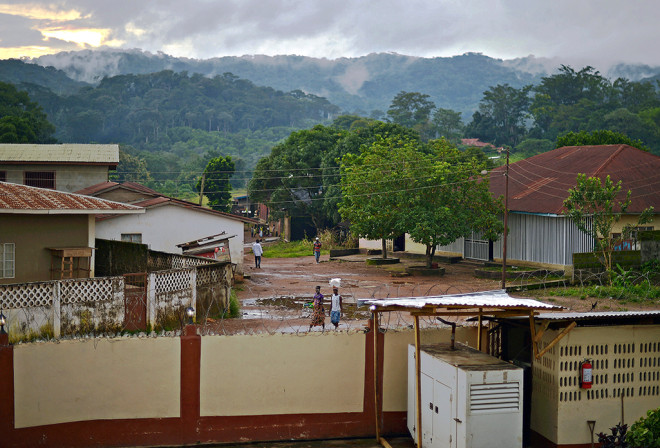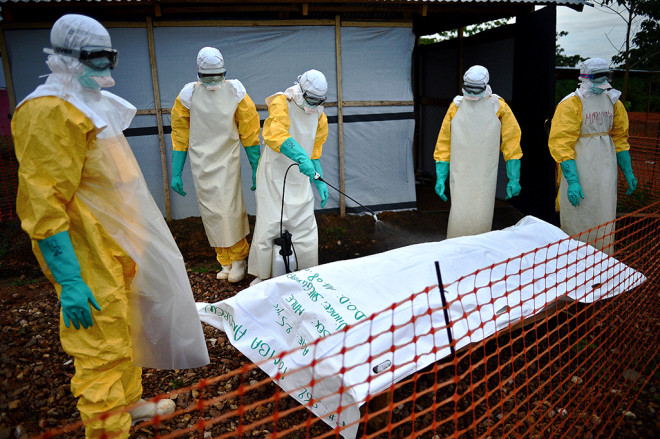
Ebola patients at an MSF treatment facility in Kailahun, on August 15, 2014. Kailahun along with Kenama district is at the epicentre of the world’s worst Ebola outbreak.  Carl De Souza/AFP/Getty
Carl De Souza/AFP/Getty
Every time Daniel Bausch, a virologist from Tulane University, went back to Guinea, things looked worse. The country’s few paved roads crumbled. The forests seemed thinner. Prices shot up on everything in the market. From 1998 to 2008, Bausch was working for the World Health Organization in West Africa, chasing a viral disease called Lassa. He had no idea at the time that he was seeing the kinds of changes that would, half a decade later, make possible the worst outbreak of Ebola the world had ever seen.
Bausch went back to Africa in July this year to work at a hospital in Sierra Leone dealing with the outbreak. Entropy was in full effect: Blood, vomit and urine smeared hospital floors. Without protective gear, some hospital workers treated Ebola patients wearing only scrubs. When nurses got sick, others went on strike, leaving few people left to pick up patients who had fallen out of their beds.
This health-care breakdown is the main reason why the virus has spread so far this time, Bausch says. It doesn’t just show up, randomly appearing from the forest. Outbreaks happen where the economy and public infrastructure have fallen apart for years.

Daniel Bausch.  Tulane
Tulane
Even now, as WHO and aid organizations work to fight the outbreak, Bausch and other disease specialists still have more questions than answers. How did it get this far? This particular strain of Ebola — called Ebola Zaire — comes from Central Africa. How did it get to West Africa? Why did it start in Guinea, which has never seen the Ebola virus? And why is this happening now?
“We’ll have to wait for the outbreak to conclude,” he says. “Even then we may never know.”
Yet despite Bausch’s pessimism, researchers are actually starting to find answers. They’re mapping out the connections between communities where people have contracted Ebola. They’re testing bats from the nearby forest to determine if Ebola has been in the area all along. They’re talking to residents about other conditions that could have caused this outbreak to spread so fast and so far—weather, government help and hospital safety. Because finding those answers will mean more than just slowing or stopping this outbreak. It might help stop the next epidemic, whatever disease it is, before it even begins.
The first problem is figuring out how this particular Ebola strain got to West Africa in the first place. Guinea residents have never encountered the disease, and now more than 500 have become ill; nearly 400 have died. This flavor of the disease—Ebola Zaire—somehow jumped up the Gulf of Guinea from Central Africa, from Gabon and the Democratic Republic of Congo.
Did it travel through an infected person? Not likely. Anyone with contagious symptoms wouldn’t make it through the 12-hour drive over tough terrain. So disease specialists are now wondering if bats migrated to West Africa. Or, perhaps more frighteningly, always harbored the virus but never had contact with humans. People may just now be catching the virus because the population of infected animals grew, or shrinking forest put more humans closer to the bats.
On the other hand, maybe Ebola has infected people in West Africa for years and nobody knew. Symptoms such as fever, muscle aches and bleeding could mean many different diseases—malaria, for example, or Lassa, which is endemic to the area. Lab tests aren’t exactly routine or widely available in these hospitals. But Bausch says testing human blood samples from Lassa research as far back as 1996 could be the answer. He and fellow researchers are developing a way to look for Ebola antibodies in samples that showed viral hemorrhagic fever symptoms but tested negative for Lassa.

People walk in a street in Kenema, Sierra Leone, on August 16, 2014. The death toll from an Ebola outbreak that began at the start of the year stands at 1,145 in four afflicted west African countries: Guinea, Sierra Leone, Liberia and Nigeria. Kailahun, the traditional home of around 30,000 mainly Mende tribespeople, and Kenema account for the lion’s share of Sierra Leone’s 810 cases and 384 deaths.  Carl De Souza/AFP/Getty
Carl De Souza/AFP/Getty
Of course, none of that would explain why this outbreak happened now. One possible explanation is the weather—disease outbreaks often accompany the transition from rainy to dry season, and this year the dry season was longer and drier than usual, which could pump up the number of virus-infected bats [[I’m not clear on how this works]]. If so, looking to the forest makes sense—the Guinea forest touches Liberia and Sierra Leone, where the outbreak has been the strongest.
Once the disease makes its way out of its animal reservoir and into people, those people become vectors for its transmission. Central Africa is more rural, which means less person-to-person contact. But West African nations are urbanized, populous, and connected, with porous borders.
Poverty exacerbates that problem, Liberia, Guinea and Sierra Leone are among the poorest countries in the world—numbers 175, 179 and 183, respectively, out of 187 countries on the United Nation’s Human Development Index. In that part of the world, poor people have to go deeper into the surrounding forest just to stay alive, hunting for food, looking for wood to build fires and goods to sell. As they push in, new and strange diseases come out.
Once infected, people find limited help back at the hospital. These countries have just one doctor for every 40,000 to 80,000 people.
“A colleague of mine working there told me they don’t have gloves and can’t afford them,” says Carlos del Rio, a global health and infectious disease expert at Emory University in Atlanta. “They can’t protect themselves. What are they supposed to do?”
Infected patients then return home, where the virus spreads and is inefficiently battled by governments with few resources, slow response times, poor communication networks and huge language barriers across borders.
All these trends and results are true for more diseases than just Ebola. In fact, the poorest communities in the U.S. all face “tropical diseases”—mosquito-borne Dengue fever; Chagas disease, which causes debilitating heart damage; and toxocariasis, a parasitic disease transmitted by roundworms.
They’re the “most important diseases you’ve never heard of,” says Peter Hotez, a virologist and founding dean of Baylor College of Medicine’s National School of Tropical Medicine. “We put a large emphasis on biodefense and imaginary threats to the U.S. with smallpox and the avian flu, but this is at the expense of the real threats that have been here a long time.”
“Calling them ‘tropical diseases’ is a misnomer,” he says. “They’re really diseases of poverty.”

Medecins Sans Frontieres (MSF) medical workers disinfect the body bag of an Ebola victim at the MSF facility in Kailahun, on August 14, 2014.  Carl De Souza/AFP/Getty
Carl De Souza/AFP/Getty
Hotez has linked these diseases to other problems—mental illness, achievement gaps and socioeconomic inequality. That’s why figuring out the Ebola question is a tall order but an increasingly important one.
“This is about gaining an understanding of the dire conditions in these countries that we have been ignoring,” del Rio says. “What happens over there matters to us. We can no longer say it’s an ‘Africa problem.’”
Bausch, now stationed in Peru at a U.S. Navy medical research station, is still on WHO’s list of Africa experts. Every day he takes calls from reporters and phones into international meetings to give advice. He sees this moment as a time to explain to the public, especially the Western world, what he’s seen firsthand on West Africa’s dilapidated roads and in its dysfunctional hospitals. As world health experts and aid organizations ramp up a response, he reminds them about the ramifications for now and in the future.
“We need to make the scale of the response commensurate with the scale of the outbreak. This has become a big deal,” Bausch says. “It takes time to mobilize people and equipment in a place that’s not organized to begin with. It’s destabilizing a region that can’t afford to be set back even more.”
When an infrastructure falls apart, more than roads crumble.